 W
WActive ageing is a concept recently deployed by the European Commission, the World Health Organization, and used also in Human Resource Management. This concept evokes the idea of longer activity, with a higher retirement age and working practices adapted to the age of the employee. It also extends to the social engagement of the elderly in the collectivity.
 W
WIn the field of ageing studies, activist ageing refers to activism and research that empowers the elderly. This approach investigates how ageing is imagined, how ageism operates, and how elders respond to exclusion.
 W
WAgequake: Riding the Demographic Rollercoaster Shaking Business, Finance and our World is a book written by Paul Wallace and published in 1999, that investigates what possible ramifications are likely as a significant and unprecedented portion of the human population age. The book argues that rising longevity and lower fertility is causing a seismic shift in the profile of populations worldwide, and will be a fundamental force to that will shake business and finance, along with lifestyles and attitudes. Wallace suggests the old bogey of overpopulation is being replaced by a population "implosion".
 W
WThe aging of Europe, also known as the greying of Europe, is a demographic phenomenon in Europe characterised by a decrease in fertility, a decrease in mortality rate, and a higher life expectancy among European populations. Low birth rates and higher life expectancy contribute to the transformation of Europe's population pyramid shape. The most significant change is the transition towards a much older population structure, resulting in a decrease in the proportion of the working age while the number of the retired population increases. The total number of the older population is projected to increase greatly within the coming decades, with rising proportions of the post-war baby-boom generations reaching retirement. This will cause a high burden on the working age population as they provide for the increasing number of the older population.
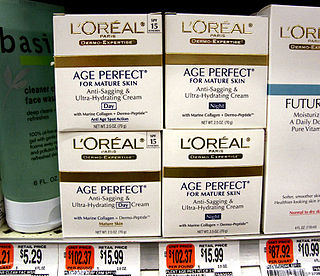 W
WAnti-aging creams are predominantly moisturiser-based cosmeceutical skin care products marketed with the promise of making the consumer look younger by reducing, masking or preventing signs of skin aging. These signs are laxity (sagging), rhytids (wrinkles), and photoaging, which includes erythema (redness), dyspigmentation, solar elastosis (yellowing), keratoses, and poor texture.
 W
WBAG family molecular chaperone regulator 1 is a protein that in humans is encoded by the BAG1 gene.
 W
WBAG family molecular chaperone regulator 3 is a protein that in humans is encoded by the BAG3 gene. BAG3 is involved in chaperone-assisted selective autophagy.
 W
WThe crude birth rate in a period is the total number of live births per 1,000 population divided by the length of the period in years. The number of live births is normally taken from a universal registration system for births; population counts from a census, and estimation through specialized demographic techniques. The birth rate is used to calculate population growth. The estimated average population may be taken as the mid-year population.
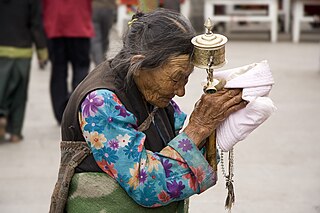 W
WThe continuity theory of normal aging states that older adults will usually maintain the same activities, behaviors, relationships as they did in their earlier years of life. According to this theory, older adults try to maintain this continuity of lifestyle by adapting strategies that are connected to their past experiences.
 W
WMitochondrial 5-demethoxyubiquinone hydroxylase, also known as coenzyme Q7, hydroxylase, is an enzyme that in humans is encoded by the COQ7 gene. The clk-1 (clock-1) gene encodes this protein that is necessary for ubiquinone biosynthesis in the worm Caenorhabditis elegans and other eukaryotes. The mouse version of the gene is called mclk-1 and the human, fruit fly and yeast homolog COQ7.
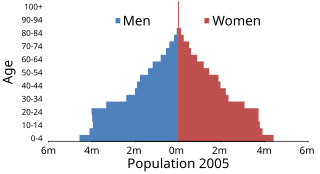 W
WAccording to the Encyclopedia of International Development, the term demographic trap is used by demographers "to describe the combination of high fertility and declining mortality in developing countries, resulting in a period of high population growth rate (PGR)." High fertility combined with declining mortality happens when a developing country moves through the demographic transition of becoming developed.
 W
WDemographic window is defined to be that period of time in a nation's demographic evolution when the proportion of population of working age group is particularly prominent. This occurs when the demographic architecture of a population becomes younger and the percentage of people able to work reaches its height. Typically, the demographic window of opportunity lasts for 30–40 years depending upon the country. Because of the mechanical link between fertility levels and age structures, the timing and duration of this period is closely associated to those of fertility decline: when birth rates fall, the age pyramid first shrinks with gradually lower proportions of young population and the dependency ratio decreases as is happening in various parts of East Asia over several decades. After a few decades, low fertility however causes the population to get older and the growing proportion of elderly people inflates again the dependency ratio as is observed in present-day Europe.
 W
WThe dependency ratio is an age-population ratio of those typically not in the labor force and those typically in the labor force. It is used to measure the pressure on the productive population.
 W
WThe disengagement theory of aging states that "aging is an inevitable, mutual withdrawal or disengagement, resulting in decreased interaction between the aging person and others in the social system he belongs to". The theory claims that it is natural and acceptable for older adults to withdraw from society. There are multiple variations on disengagement theory, such as moral disengagement.
 W
WGeriatrics, or geriatric medicine, is a specialty that focuses on health care of elderly people. It aims to promote health by preventing and treating diseases and disabilities in older adults. There is no set age at which patients may be under the care of a geriatrician, or geriatric physician, a physician who specializes in the care of elderly people. Rather, this decision is determined by the individual patient's needs, and the availability of a specialist. It is important to note the difference between geriatrics, the care of aged people, and gerontology, which is the study of the aging process itself. The term geriatrics comes from the Greek γέρων geron meaning "old man", and ιατρός iatros meaning "healer". However, geriatrics is sometimes called medical gerontology.
 W
WGerontology is the study of the social, cultural, psychological, cognitive, and biological aspects of aging. The word was coined by Ilya Ilyich Mechnikov in 1903, from the Greek γέρων, geron, "old man" and -λογία, -logia, "study of". The field is distinguished from geriatrics, which is the branch of medicine that specializes in the treatment of existing disease in older adults. Gerontologists include researchers and practitioners in the fields of biology, nursing, medicine, criminology, dentistry, social work, physical and occupational therapy, psychology, psychiatry, sociology, economics, political science, architecture, geography, pharmacy, public health, housing, and anthropology.
 W
WGerovital H3 is a preparation developed during the 1950s and promoted by its advocates as an effective anti-aging treatment. In the United States, the FDA bans Gerovital H3 from interstate commerce as an unapproved drug and, since 1982, has prohibited its importation.
 W
WIntergenerational equity in economic, psychological, and sociological contexts, is the concept or idea of fairness or justice between generations. The concept can be applied to fairness in dynamics between children, youth, adults and seniors, in terms of treatment and interactions. It can also be applied to fairness between generations currently living and generations yet to be born.
 W
WThe kynurenine pathway is a metabolic pathway leading to the production of nicotinamide adenine dinucleotide (NAD+), as well as other active metabolites, from the degradation of tryptophan, an essential amino acid. Disruption in the pathway is associated with certain genetic disorders.
 W
WThe mitochondrial theory of aging has two varieties: free radical and non-free radical. The first is one of the variants of the free radical theory of aging. It was formulated by J. Michel in 1980 and was developed in the works of A. V. Linnan (1989). The second was proposed by A. N. Lobachev in 1978.
 W
WMuscle atrophy is the loss of skeletal muscle mass that can be caused by immobility, aging, malnutrition, medications, or a wide range of injuries or diseases that impact the musculoskeletal or nervous system. Muscle atrophy leads to muscle weakness and causes disability.
 W
WA population pyramid, also called an "age-gender-pyramid", is a graphical illustration that shows the distribution of various age groups in a population, which forms the shape of a pyramid when the population is growing. Males are conventionally shown on the left and females on the right, and they may be measured by raw number or as a percentage of the total population. This tool can be used to visualize the age of a particular population. It is also used in ecology to determine the overall age distribution of a population; an indication of the reproductive capabilities and likelihood of the continuation of a species.
 W
WShòu is the Chinese word/character for "longevity".
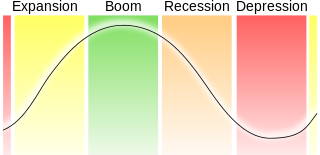 W
WIn the economics of demography, the term spending wave refers to the economic effect of departure of children from the home. When a society experiences a high level of such family change then an economic decline follows from reduced spending overall.
 W
WExecutive functions are a cognitive apparatus that controls and manages cognitive processes. Norman and Shallice (1980) proposed a model on executive functioning of attentional control that specifies how thought and action schemata become activated or suppressed for routine and non-routine circumstances. Schemas, or scripts, specify an individual's series of actions or thoughts under the influence of environmental conditions. Every stimulus condition turns on the activation of a response or schema. The initiation of appropriate schema under routine, well-learned situations is monitored by contention scheduling which laterally inhibits competing schemas for the control of cognitive apparatus. Under unique, non-routine procedures the supervisory attentional system (SAS) controls schema activation. The SAS is an executive monitoring system that oversees and controls contention scheduling by influencing schema activation probabilities and allowing for general strategies to be applied to novel problems or situations during automatic attentional processes.
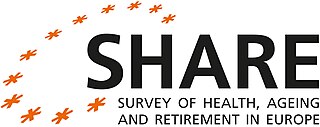 W
WThe Survey of Health, Ageing and Retirement in Europe (SHARE) is a multidisciplinary and cross-national panel database of micro data on health, socio-economic status and social and family networks. In seven survey waves to date, SHARE has conducted approximately 380,000 interviews with about 140,000 individuals aged 50 and over. The survey covers 27 European countries and Israel.
 W
WThe Up series is a series of documentary films produced by Granada Television for ITV that follows the lives of fourteen British children since 1964, when they were seven years old. The documentary has had nine episodes—one episode every seven years—thus spanning 56 years. All were broadcast on ITV, apart from the sixth episode that was broadcast on BBC One. Individual films and the series as a whole have received numerous accolades; the fourth episode, 28 Up, was chosen for Roger Ebert's list of the ten greatest films of all time.
 W
WA wrinkle, also known as a rhytide, is a fold, ridge or crease in otherwise smooth surface, such as on skin or fabric. Skin wrinkles typically appear as a result of aging processes such as glycation, habitual sleeping positions, loss of body mass, sun damage, or temporarily, as the result of prolonged immersion in water. Age wrinkling in the skin is promoted by habitual facial expressions, aging, sun damage, smoking, poor hydration, and various other factors. In humans, it can also be prevented to some degree by avoiding excessive solar exposure and through diet (in particular through consumption of carotenoids, tocophenols and flavonoids, vitamins, essential omega-3-fatty acids, certain proteins and lactobacilli.